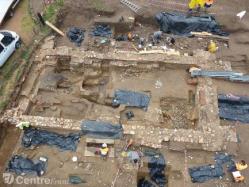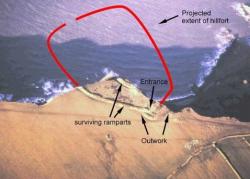INSTITUT SUPERIEUR D'ANTHROPOLOGIE
INSTITUTE OF ANTHROPOLOGY
ONLINE COURSES / COURS A DISTANCE
INSCRIPTION 2012 / Session III : Juillet 2012
REGISTRATION 2012 / Term III : July 2012
QATAR –  - Wadi Debayan - In a major development for the archaeological excavations across Qatar, an unmarked grave has been discovered at Wadi Debayan, an important site with human occupation dating back to about 7,500 years ago. The exploration of Wadi Debayan, situated on the northwestern side of Qatar to the south of the site of Al Zubara and the Rá’s ‘Ushayriq peninsula, is part of the Remote Sensing and Qatar National Historical Environment Record (QNHER) Project. “We have come across one burial, probably a full skeleton and though we cannot say that we have a cemetery there, it is a fair possibility,” project co-director Richard Cuttler told. “The grave was a very surprising find that came out of one of the several test pits. We have seen some pieces of the tibia, one of the two leg bones, which shows the skeleton is in a crouched position typical of Neolithic burials” he explained. “The bone fragments are very fragile and we need to sit back and think how to go about this. We also need to consult some osteologists and get more information,” Cuttler said. By working with a complete skeleton or even bone fragments, osteologists can determine facts including the deceased individual’s age, sex, diet and illnesses. “The only other site I can think in the Gulf similar to this is the one at Jebel Al Buhais in Sharjah, the UAE, and there they had Neolithic cemeteries with no markers on the surface,” the expert recalled. Wadi Debayan, one of the earliest Neolithic-Chalcolithic sites in the Gulf, has beneath its surface some of the earliest known structures in Qatar. The fact that the site had human inhabitation as early as 7,500 years ago was proved scientifically during summer last year when samples from one of the post holes were radio carbon dated. “When we first found the site, we thought well may be we have just got a flint scatter here, but when we began excavation we found lots of fire pits and many, many post holes”, explained al-Naimi, also a co-director of the project. Evidence so far indicates that Wadi Debayan had about 3,000 years of occupation. It may not be the same people or continuous occupation.
- Wadi Debayan - In a major development for the archaeological excavations across Qatar, an unmarked grave has been discovered at Wadi Debayan, an important site with human occupation dating back to about 7,500 years ago. The exploration of Wadi Debayan, situated on the northwestern side of Qatar to the south of the site of Al Zubara and the Rá’s ‘Ushayriq peninsula, is part of the Remote Sensing and Qatar National Historical Environment Record (QNHER) Project. “We have come across one burial, probably a full skeleton and though we cannot say that we have a cemetery there, it is a fair possibility,” project co-director Richard Cuttler told. “The grave was a very surprising find that came out of one of the several test pits. We have seen some pieces of the tibia, one of the two leg bones, which shows the skeleton is in a crouched position typical of Neolithic burials” he explained. “The bone fragments are very fragile and we need to sit back and think how to go about this. We also need to consult some osteologists and get more information,” Cuttler said. By working with a complete skeleton or even bone fragments, osteologists can determine facts including the deceased individual’s age, sex, diet and illnesses. “The only other site I can think in the Gulf similar to this is the one at Jebel Al Buhais in Sharjah, the UAE, and there they had Neolithic cemeteries with no markers on the surface,” the expert recalled. Wadi Debayan, one of the earliest Neolithic-Chalcolithic sites in the Gulf, has beneath its surface some of the earliest known structures in Qatar. The fact that the site had human inhabitation as early as 7,500 years ago was proved scientifically during summer last year when samples from one of the post holes were radio carbon dated. “When we first found the site, we thought well may be we have just got a flint scatter here, but when we began excavation we found lots of fire pits and many, many post holes”, explained al-Naimi, also a co-director of the project. Evidence so far indicates that Wadi Debayan had about 3,000 years of occupation. It may not be the same people or continuous occupation.
http://www.gulf-times.com/site/topics/article.asp?cu_no=2&item_no=503582&version=1&template_id=57&parent_id=56
FRANCE –  Caussade - Sur le site de la place du Fil, située derrière l'église Notre-Dame, où un îlot déclaré insalubre avait été entièrement démoli en avril 2008, l'Inrap a effectué, dans la semaine, une série de sondages ponctuels destinés à fouiller le sous-sol à la recherche de vestiges. «Ces recherches sont destinées à lever les hypothèques archéologiques en amont des travaux de réaménagement prévus», explique l'architecte, qui est parvenue à récupérer quelques morceaux de céramiques datant des XIIe et XIVe siècles, ce qui constitue, à ses yeux, une découverte intéressante qui pourrait éventuellement entraîner d'autres fouilles plus approfondies. «On peut déjà constater que cet espace a été continuellement réaménagé depuis la construction du château et même antérieurement puisqu'on a trouvé un élément de poterie datant du XIIe siècle», ajoute Catherine Viers.
Caussade - Sur le site de la place du Fil, située derrière l'église Notre-Dame, où un îlot déclaré insalubre avait été entièrement démoli en avril 2008, l'Inrap a effectué, dans la semaine, une série de sondages ponctuels destinés à fouiller le sous-sol à la recherche de vestiges. «Ces recherches sont destinées à lever les hypothèques archéologiques en amont des travaux de réaménagement prévus», explique l'architecte, qui est parvenue à récupérer quelques morceaux de céramiques datant des XIIe et XIVe siècles, ce qui constitue, à ses yeux, une découverte intéressante qui pourrait éventuellement entraîner d'autres fouilles plus approfondies. «On peut déjà constater que cet espace a été continuellement réaménagé depuis la construction du château et même antérieurement puisqu'on a trouvé un élément de poterie datant du XIIe siècle», ajoute Catherine Viers.
http://www.ladepeche.fr/article/2012/05/05/1346186-caussade-fouilles-au-chateau-des-decouvertes.html
FRANCE –  Givrette – Les archéologues interviennent depuis le début du mois de mars et jusqu'à la fin mai, en amont des travaux de construction d'une habitation. Située rue de la Prade, cette opération archéologique effectuée sur prescription de l'État (DRAC Auvergne) s'attache à la fouille et l'étude de l'église Saint-Pardoux et de son cimetière. De nombreux habitants de Domérat ont bien connu cette église qui s'élevait jusqu'à une date récente, à Givrette, peu d'entre eux, en revanche, soupçonnaient son ancienneté. En effet, érigé sur une plateforme artificielle, probablementau IX e ou au X e siècle, l'édifice et le cimetière qui l'entoure appartiennent à un ensemble plus vaste : une motte castrale, une butte sur laquelle s'élevait une tour protégée par un fossé. La fouille en cours a d'ores et déjà permis de dégager les vestiges de l'église, à l'intérieur de laquelle trois moules à cloches ont été observés. Le tracé du fossé a par ailleurs pu être suivi sur une quinzaine de mètres. Près de 150 sépultures médiévales ont été étudiées. À l'intérieur de ce cimetière, trois silos à grains ont enfin été repérés.
Givrette – Les archéologues interviennent depuis le début du mois de mars et jusqu'à la fin mai, en amont des travaux de construction d'une habitation. Située rue de la Prade, cette opération archéologique effectuée sur prescription de l'État (DRAC Auvergne) s'attache à la fouille et l'étude de l'église Saint-Pardoux et de son cimetière. De nombreux habitants de Domérat ont bien connu cette église qui s'élevait jusqu'à une date récente, à Givrette, peu d'entre eux, en revanche, soupçonnaient son ancienneté. En effet, érigé sur une plateforme artificielle, probablementau IX e ou au X e siècle, l'édifice et le cimetière qui l'entoure appartiennent à un ensemble plus vaste : une motte castrale, une butte sur laquelle s'élevait une tour protégée par un fossé. La fouille en cours a d'ores et déjà permis de dégager les vestiges de l'église, à l'intérieur de laquelle trois moules à cloches ont été observés. Le tracé du fossé a par ailleurs pu être suivi sur une quinzaine de mètres. Près de 150 sépultures médiévales ont été étudiées. À l'intérieur de ce cimetière, trois silos à grains ont enfin été repérés.
http://www.lamontagne.fr/auvergne/actualite/departement/allier/allier-local/2012/05/05/portes-ouvertes-sur-les-fouilles-de-givrette-1160212.html
ROYAUME UNI –  Embury Beacon - A team of archaeologists will be surveying and excavating the remains of a hill fort before it is lost to the waves forever. The work at Embury Beacon in Hartland will be a race against time to save the remaining 25 per cent of the fort. Previous surveys suggest that the monument may have enclosed the crest of a prominent coastal headland, most of which has eroded away in the last 2,000 years. The current excavations, which began on April 16 by a team of volunteers, are examining how the original entrance opened.
Embury Beacon - A team of archaeologists will be surveying and excavating the remains of a hill fort before it is lost to the waves forever. The work at Embury Beacon in Hartland will be a race against time to save the remaining 25 per cent of the fort. Previous surveys suggest that the monument may have enclosed the crest of a prominent coastal headland, most of which has eroded away in the last 2,000 years. The current excavations, which began on April 16 by a team of volunteers, are examining how the original entrance opened.
http://www.northdevongazette.co.uk/news/race_against_time_to_save_hill_fort_1_1368697
ROYAUME UNI –  Fyvie Castle - Experts excavating at Fyvie Castle, near Turriff, expected to uncover a 400-year-old garden. Instead they have discovered what they believe to be an 800-year-old defence system which they believe will help them learn more about the castle's history. Archaeologist Alison Cameron said: "Initially when I was digging down one of these post holes I found a huge piece of 13th century pottery which I knew hadn't been moved around a lot, so I was thinking there was probably some structure underneath. "It's potentially very significant. If it was possible to uncover more post holes and find out more about this structure it would be one of the only excavations which has taken place in Scotland of 13th century defences of a castle."
Fyvie Castle - Experts excavating at Fyvie Castle, near Turriff, expected to uncover a 400-year-old garden. Instead they have discovered what they believe to be an 800-year-old defence system which they believe will help them learn more about the castle's history. Archaeologist Alison Cameron said: "Initially when I was digging down one of these post holes I found a huge piece of 13th century pottery which I knew hadn't been moved around a lot, so I was thinking there was probably some structure underneath. "It's potentially very significant. If it was possible to uncover more post holes and find out more about this structure it would be one of the only excavations which has taken place in Scotland of 13th century defences of a castle."
VIDEO - http://news.stv.tv/scotland/98218-archaeologists-uncover-medieval-defences-on-grounds-of-historic-castle/